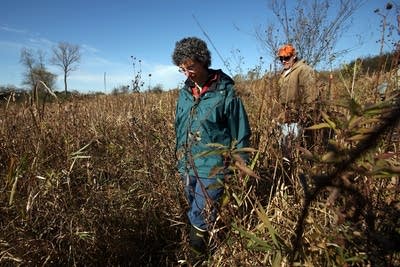Minnesota Sounds and Voices: Preserving Chaska's Seminary Fen
Go Deeper.
Create an account or log in to save stories.
Like this?
Thanks for liking this story! We have added it to a list of your favorite stories.

Seminary Fen, on the edge of the Twin Cities, with its prairie sedge, swamp thistle, goldenrod and marsh marigolds, has had its share of threats. More than a century ago, Shakopee's Mudcura Sanitarium scooped its mud for spa baths. At other times, farmers tried to drain the wetland, to make way for more arable land.
But like the tiny stream that feeds it, the Seminary Fen survives. And one October afternoon, Russell Smith from the Minnesota Department of Natural Resources led the way on a bushwhack walk to offer a MPR News reporter a glimpse into the protected, ecological gem near Chaska.
"It's a little tricky getting out here," he says, even though summer's jungle-like maze of reed grass, and blooming native orchids and asters are long gone. "You can't even see where you are walking."
There's no doubt where the fen begins, though. Underfoot, one can feel a patch of springy, mattress-like grass. "Sometimes that's what we do to try figure out if we're in a fen or not: We bounce up and down."
Turn Up Your Support
MPR News helps you turn down the noise and build shared understanding. Turn up your support for this public resource and keep trusted journalism accessible to all.
Another DNR specialist, Hannah Texler, looks down at another piece of fen evidence, a very clear little stream. "You can see watercress growing in it," she says of the cold, clear water that feeds nearby Assumption Creek, a former haven for native brook trout. But the disappearance of the trout offers just one clue that Seminary Fen, and other wetlands like it, continue to be threatened by development.
"We're still trying to figure out exactly why the trout aren't here and if they might come back, or if we might be able to restock them," Trexler says of the living biological classroom. She calls the trout a marker for how the health of the rest of the planet is doing.
"Places like this, natural areas with rare plants in them and a lot of wildlife are indicators of ecosystem health," Trexler says. "If we lose all of those, we start to lose healthy places for humans to live."
---
More:
To listen to this latest edition of reporter Dan Olson's "Minnesota Sounds and Voices," click on the audio link, above.
To learn more about fens, visit the Department of Natural Resources, or the Environmental Protection Agency.
Dear reader,
Political debates with family or friends can get heated. But what if there was a way to handle them better?
You can learn how to have civil political conversations with our new e-book!
Download our free e-book, Talking Sense: Have Hard Political Conversations, Better, and learn how to talk without the tension.







